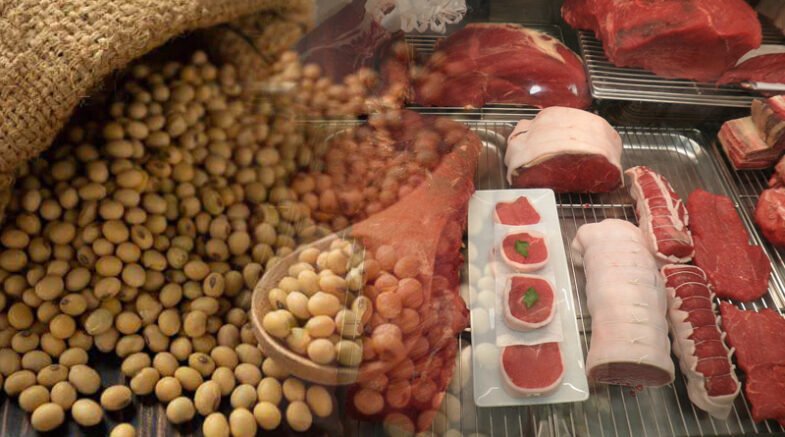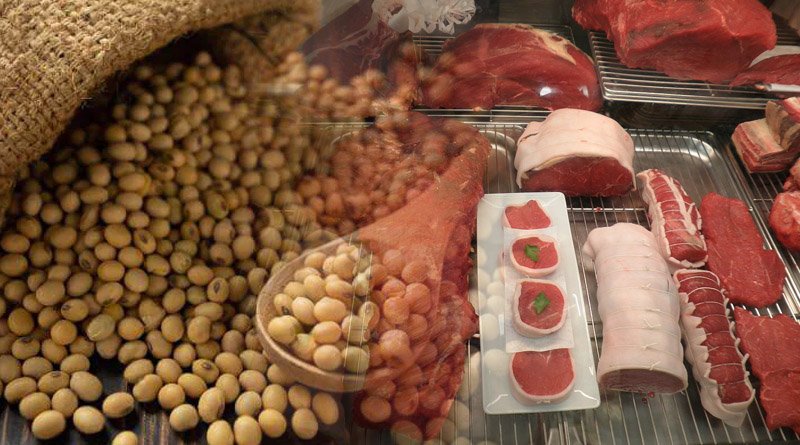Soybean is considered to be a high-quality plant-based protein source and is often used as replacement to meat in vegetarian and vegan diets.

Soybean (Glycine max) is a versatile and widely cultivated legume that has been an important crop for thousands of years. In this review article, we discuss the history, cultivation, nutritional properties, health benefits, soybean as a replacement for meat, the future of soybean in Pakistan, the financial value of soybean in Pakistan, applications of soybean, and a conclusion.
Soybean is an excellent source of protein and other essential nutrients and has numerous health benefits, including reducing the risk of heart disease, osteoporosis, and certain types of cancer.
Soybean is used in a variety of food, feed, and industrial products and has significant economic and environmental impacts. This review provides an overview of the importance of soybean, highlighting its nutritional and health benefits as well as its uses and challenges.
Introduction
Soybean (Glycine max) is a legume that has been cultivated for thousands of years, primarily in Asia. Today, it is one of the most important crops worldwide, with over 300 million metric tons produced annually. Soybean is an excellent source of protein, containing all of the essential amino acids as well as other essential nutrients such as fiber, vitamins, and minerals.
In addition, soybeans have numerous health benefits, including reducing the risk of heart disease, osteoporosis, and certain types of cancer.
Soybean is used in a variety of food, feed, and industrial products, such as tofu, soymilk, animal feed, and biodiesel. It has significant economic and environmental impacts, with soybean production contributing to the livelihoods of millions of people and the conservation of natural resources.
However, soybean production also has challenges, including environmental concerns, such as deforestation and pesticide use, and the potential for genetic contamination of non-GMO crops.
Overview
In this review, we provide an overview of the importance of soybean, highlighting its nutritional and health benefits, as well as its uses and challenges, along with the future and financial aspects of soybean in Pakistan. We also discuss the history and cultivation of soybean, including its origins in China, spread to other parts of Asia, and introduction to North and South America.
History and Cultivation:
Soybean originated in China over 5,000 years ago and has since spread to other parts of Asia, as well as North and South America. Today, it is one of the most important crops worldwide, with over 300 million metric tons produced annually. The United States is the largest producer, followed by Brazil, Argentina, and China.
Soybean is a hardy plant that can be grown in various climates and soil types. It is typically planted in the spring and harvested in the fall. Soybeans can be grown using conventional or organic methods and can be genetically modified to resist pesticides and herbicides. However, the use of genetically modified soybeans has raised concerns about potential health and environmental risks.
Nutritional Properties:
Soybean is an excellent source of protein, containing all of the essential amino acids needed for human health. In addition, soybeans are a good source of fiber, vitamins, and minerals. Soybean products, such as tofu and soymilk, are popular among vegetarians and vegans because of their high protein content.
Health Benefits:
Soybean has numerous health benefits, including reducing the risk of heart disease, osteoporosis, and certain types of cancer. Soybean contains compounds called isoflavones, which have been shown to have anti-inflammatory and antioxidant effects. Isoflavones may also have a protective effect against breast and prostate cancer.
Soybean as a Replacement for Meat:
Soybean is considered to be a high-quality plant-based protein source and is often used as replacement to meat in vegetarian and vegan diets. Soybeans contain all nine essential amino acids that the body needs to build proteins, making them a complete protein source. In fact, soybeans have a protein content of about 36–56%, which is comparable to that of meat products.
One of the key advantages of soybean over meat is that it is cholesterol-free, which is particularly beneficial for individuals with high cholesterol levels.
Additionally, soybean is low in saturated fat and high in unsaturated fats, which have been shown to be beneficial for heart health. Soybean also contains various bioactive compounds, such as isoflavones, which have been associated with a range of health benefits, including a reduced risk of cardiovascular disease, certain cancers, and osteoporosis.
The use of soybean as a meat replacement has become increasingly popular, with the development of soy-based products that mimic the texture and flavor of meat. These products, such as tofu, tempeh, and soy burgers, provide a viable alternative to meat for those looking to reduce their meat consumption or transition to a plant-based diet.
Overall, the high protein content and numerous health benefits of soybeans make them a promising replacement for meat. As the demand for plant-based proteins continues to grow, soybeans are likely to play an increasingly important role in meeting this demand.
The future of soybeans in Pakistan
The future of soybeans in Pakistan looks promising, with the government and other stakeholders taking steps to increase soybean production and utilisation.
The government has recognized the potential of soybean as a high-value crop and has included it in its agricultural development programs. In addition, several private companies are investing in soybean processing facilities to produce soy-based food products and animal feed.
One challenge for soybean production in Pakistan is the availability of high-quality seeds and the need for improved agronomic practices.
The government and private sector are working to address these issues by promoting the use of improved seed varieties and providing technical assistance to farmers.
In addition to increasing production, there is also growing interest in developing value-added soy-based products in Pakistan. This includes the production of soy-based food products, such as tofu and soymilk, as well as the use of soybean in animal feed and industrial applications.
Overall, the future of soybeans in Pakistan looks bright, with increasing demand for soy-based products and a supportive policy environment.
With continued investment in research and development and a focus on sustainable production practices, soybeans have the potential to become an important crop in Pakistan, contributing to both food security and economic development.
Financial Value of Soybeans in Pakistan
Soybean is an important crop in Pakistan, both in terms of its economic and nutritional value. According to the Pakistan Bureau of Statistics, the total area under soybean cultivation in Pakistan increased from 55,000 hectares in 2015-16 to 68,000 hectares in 2018-19, indicating its growing importance in the country’s agriculture sector. In terms of production, the total output of soybeans in Pakistan was estimated to be around 120,000 metric tons in 2018–19.
Soybean replacement for meat is used in a variety of food products in Pakistan, such as tofu, soy milk, and soy sauce. It is also used as animal feed, with the majority of soybean production in Pakistan being used for this purpose.
The demand for soybean as a feed ingredient has increased in recent years due to the growth of the poultry and livestock sectors in the country.
In addition to their nutritional value, soybeans also have significant financial value in Pakistan. According to the Pakistan Economic Survey 2020–21, the value of soybean production in Pakistan was estimated to be around 6.7 billion Pakistani rupees (approximately 43 million US dollars) in 2019–20. This represents a significant contribution to the country’s agricultural economy.
The increasing demand for soybean in Pakistan is also driving investment in the crop, with various government and private sector initiatives aimed at increasing its production and improving its quality. For example, the Punjab Agriculture Department has introduced high-yielding soybean varieties and provided farmers with training on improved cultivation practices.
Similarly, private sector companies such as Cargill and ADM have established soybean processing facilities in the country, which are expected to further boost the crop’s value.
Overall, the financial value of soybeans in Pakistan is significant and is likely to continue to grow in the coming years as the demand for soy-based products and animal feed continues to increase.
Applications:
Soybean is used in a variety of food, feed, and industrial products. It is a common ingredient in Asian cuisine and is used to make tofu, soymilk, and other soy-based products. Soybean is also a major component of animal feed, particularly for poultry and swine. In addition, soybean is used in the production of biodiesel and other industrial products.
Challenges:
Despite its many benefits, soybean production has challenges. The cultivation of soybeans has been linked to deforestation, particularly in South America, where large areas of rainforest have been cleared to make way for soybean plantations.
In addition, the use of pesticides and fertilizers in soybean production has raised environmental concerns. The use of genetically modified soybeans has also raised concerns about the potential for genetic contamination of non-GMO crops.
Conclusion:
Soybean is a versatile and widely cultivated legume that has been an important crop for thousands of years. It is an excellent source of protein and other essential nutrients and has numerous health benefits, including reducing the risk of heart disease, osteoporosis, and certain types of cancer.
Soybean replacement of meat is used in a variety of food, feed, and industrial products, and has significant economic and environmental impacts. However, soybean production also has challenges, including environmental concerns and the potential for genetic contamination of non-GMO crops.
Overall, soybean remains an important crop with significant nutritional and economic value. The economic value of soybean is very important as Pakistan is a developing country and the country is heading towards cultivating more soybean as well as it is a paying crop in Pakistan because of use of soybean in animal feed as well as for edible purposes.
